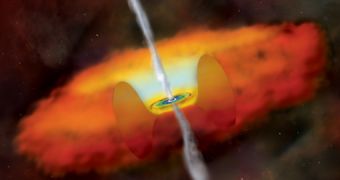Black holes are definitely the most fascinating aspect in the vastness of space, even if we don't know an awful lot about them. Actually, we don't even know whether they really exist or not yet, but theory says they should exist; otherwise, some things that are known to happen would be even weirder. But out of the little that we know about black holes, quite a lot is actually wrong. Here's a short list of a few things you might not know, or at least not accurately (for a longer version, go here).
Their force doesn't rely on mass, but on size. Black holes usually form when a star runs out of fuel. Then, its core collapses, releasing a Shockwave that causes the outer layers to explode in a supernova, while its gravity continuously increases. If the core is sufficiently massive (three times Sun's mass), its gravity gets so big that the speed needed by anything to escape from it (escape velocity) equals that of light. The region where this happens is called the event horizon.
They can have a low density. If mass is added by the things a black hole attracts, its gravity increases as well, causing the sphere of the event horizon to expand as well, directly proportional to the mass. This is weird, since if you clump together the material from two spheres, you don't get one that's twice bigger. Geometry says the volume of a sphere is the cube of its radius. So, in order to obtain a sphere twice larger, you'd have to throw in the material from 2x2x2=8 spheres, which is not true for black holes' event horizon, which relies on gravity to grow. And since there is not enough material thrown in and it still grows so much, its density can be small.
They are not infinitely small. Common knowledge has it that the star core keeps collapsing until it reaches the size of a geometric dot which is, in fact, sizeless - it has no dimensions. But it's not true. It does, indeed, shrink to sizes that we cannot measure for the moment (less than any known particle), up to the Planck Length of 10-35 meters, which physics believes it's the absolute minimum. But hey, that's not zero, right?
In fact, black holes can get pretty huge. When two or more of them collide or eat enough matter, they can reach enormous sizes (think the ones in galaxy cores), like billions of times the mass of the Sun. But the heat from the swallowed matter acts as a powerful wind that prevents further matter from entering the suction area of the event horizon, and thus the hole from feeding, stabilizing the region.
Not all black holes are completely black. They don't swallow all matter. Think of a water vortex in a bathtub. Sometimes, matter gathers in a rotating disk around the suction zone. The same happens with black holes; except for the fact that this matter gets so hot from the friction (inner matter spins faster than that from the outer part of the disk of conglomerate matter) that it glows brightly. Also, magnetism and other physical forces cause two intense beams to be emitted from the middle of the disk, shedding quite some light on the black hole.
They don't have a funnel or circle shape, but a spherical form. The space bending concept that associates it to a sheet being bent by a heavy ball does not apply to black holes, since their gravity affects space three dimensionally, therefore they look like dark spheres.
Black holes spin. Since the stars from which they are created spin, and the collapsing cores do so at even increasing speeds (neutron stars – cores that don't make it as a black hole – are known to spin hundreds of times per second), it is only logic that black holes do the same, impressing the same motion on the swallowed matter.
Everything becomes awkward near black holes. The spinning motion in the event horizon distorts space, creating a zone just outside it called an ergosphere, an oblate sphere where nothing can sit still, as universe itself travels at the speed of light in the direction imposed by the rotation of the black hole. Hovering would mean moving at a speed faster than light in another direction than that of the black hole.
When a black hole kills, it would do so in a gruesome fashion. Gravity relies on the distance towards an object. This translates into the fact that the near end of a long object influenced by gravity would suffer stronger tugs than the farther one. But in the case of a black hole, this gets weird meanings. If you happened to fall into a black hole, the difference between the gravity applied on your feet and that to which your head is subjected would be enormous, which would result in your feet getting pulled away from your head by a force hundreds of millions of times higher than Earth's gravity, in a spaghettification phenomenon, as scientists call it.
But black holes are not necessarily dangerous. As stated, the impact of a black hole depends on its size, mass, and distance from an object. So, if the Sun was swapped with a black hole of exactly the same proportions, contrarily to what you might believe, this wouldn't mean that the Earth would be sucked in and squashed. Instead, since we're talking about the same mass, size and distance, our planet would continue to orbit the black hole in exactly the same manner as it spins around the Sun, although we would instantly freeze.

 14 DAY TRIAL //
14 DAY TRIAL //